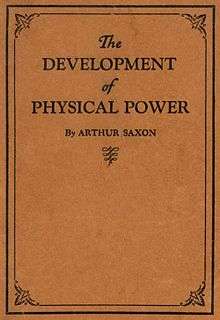Arthur Saxon
| Arthur Saxon | |
|---|---|
.jpg) | |
| Born |
Arthur Hennig April 28, 1878 Leipzig, Kingdom of Saxony, German Empire |
| Died |
August 6, 1921 (aged 43) Duisburg, Weimar Germany |
| Occupation | Strongman, circus performer |
Arthur Saxon (April 28, 1878 – August 6, 1921), born Arthur Hennig and nicknamed "The Iron-Master", was a German strongman and circus performer from the late 19th century into the early 20th century. Saxon is most well known for the bent press, with which he set a world record of 168 kg (370 lbs) (although there are claims that he has done 175 kg (385 lbs).) as well as the "two hands anyhow" lift of 203 kg (448 lbs). Usually, Saxon is depicted with his recognizable mustache.
Career
Arno Patschke, known as Arno Saxon on stage, a performer and former Greco-Roman wrestling player from Germany was eager to make money performing strongman acts. He traveled to Leipzig, where he convinced Oscard Hilgenfeldt and Arthur Hennig to join him in creating the "Greatest Strong Show" in the country.
Eventually Arthur's two brothers, Kurt and Hermann joined the group as well, forming the "Saxon Trio," and in 1897, the Trio began performing for a circus in Europe. In one act, Arthur Saxon lifted his seated brothers on a barbell with one arm. Another popular portion of their performances included opening the stage for anyone who challenged the validity of any lift.

At one point during a bent press performance Saxon claimed the act could not be repeated by the famous Eugen Sandow. Unbeknownst to Saxon, on February 26, 1898, Sandow, in the audience at the time, accepted the challenge. Sandow was unable to replicate the lift and, in retaliation, took the Saxon Trio to court. In the case Sandow won with a ruling that he had "handled the bell in exactly the same bodily attitude as Arthur", the judge not fully understanding the lift.
Publications
_(front_cover).jpg)
In 1905, Saxon published The Development of Physical Power, which explains his methods for performing lifts including the usage of barbells, dumbbells, and kettlebells, as well as Ring, Ball and Square lifting. This book also depicts Saxon displaying the lifts in 45 pages of photographs.
Saxon's The Text Book of Weight-Lifting, published in 1910, includes some psychological explanation of lifting, rather than strict routine. He explains several lifts, such as the famous bent press and continental lifts.
Death
During his service in World War I, Saxon suffered from malnutrition. After the war he tried to continue his strongman act, which conflicted with his unhealthy condition. He grew weaker and developed tuberculosis. Saxon eventually developed pneumonia, causing his death on August 6, 1921, at age 43.